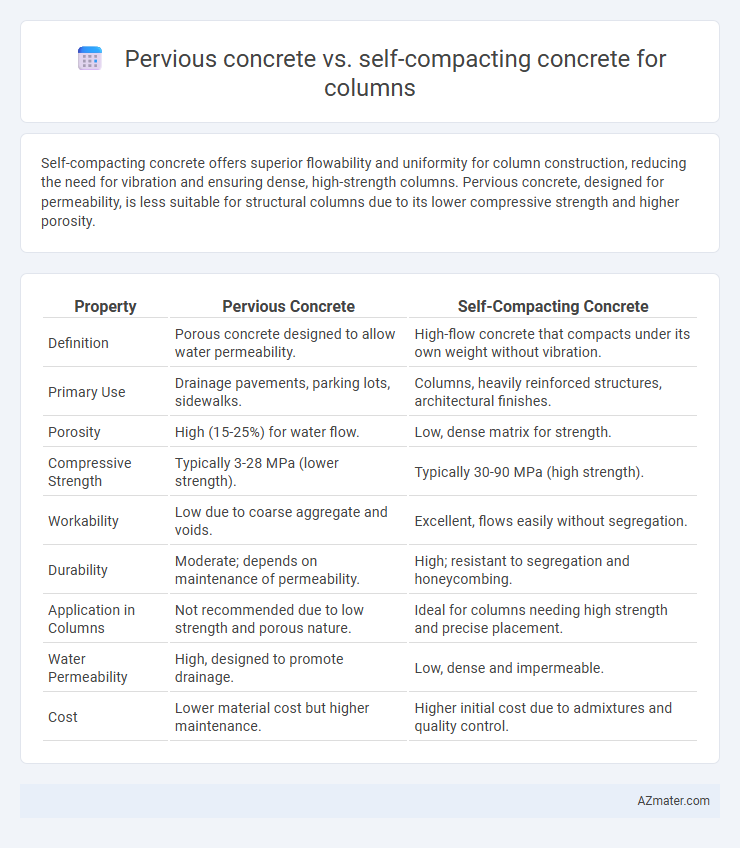Self-compacting concrete offers superior flowability and uniformity for column construction, reducing the need for vibration and ensuring dense, high-strength columns. Pervious concrete, designed for permeability, is less suitable for structural columns due to its lower compressive strength and higher porosity.
Table of Comparison
| Property | Pervious Concrete | Self-Compacting Concrete |
|---|---|---|
| Definition | Porous concrete designed to allow water permeability. | High-flow concrete that compacts under its own weight without vibration. |
| Primary Use | Drainage pavements, parking lots, sidewalks. | Columns, heavily reinforced structures, architectural finishes. |
| Porosity | High (15-25%) for water flow. | Low, dense matrix for strength. |
| Compressive Strength | Typically 3-28 MPa (lower strength). | Typically 30-90 MPa (high strength). |
| Workability | Low due to coarse aggregate and voids. | Excellent, flows easily without segregation. |
| Durability | Moderate; depends on maintenance of permeability. | High; resistant to segregation and honeycombing. |
| Application in Columns | Not recommended due to low strength and porous nature. | Ideal for columns needing high strength and precise placement. |
| Water Permeability | High, designed to promote drainage. | Low, dense and impermeable. |
| Cost | Lower material cost but higher maintenance. | Higher initial cost due to admixtures and quality control. |
Introduction: Pervious Concrete and Self-Compacting Concrete in Columns
Pervious concrete and self-compacting concrete serve distinct functions in column construction, with pervious concrete designed for enhanced permeability to facilitate drainage and reduce runoff. Self-compacting concrete offers superior flowability and consolidation without mechanical vibration, ensuring dense, uniform columns with high structural integrity. Selecting between these concretes depends on project-specific requirements such as drainage needs, surface finish, and load-bearing capacity.
Material Composition: Key Differences
Pervious concrete for columns features a highly porous mixture made from coarse aggregates, minimal fine aggregates, and limited cement paste to enhance water permeability and reduce runoff. Self-compacting concrete consists of a dense mix with fine and coarse aggregates, chemical admixtures like superplasticizers, and a higher cement content to achieve flowability and self-leveling properties without segregation. The fundamental material difference lies in pervious concrete's open void system for permeability versus self-compacting concrete's dense, cohesive matrix emphasizing workability and strength.
Workability and Placement Efficiency
Pervious concrete offers excellent permeability but has lower workability and requires careful placement to avoid segregation, making it less efficient for column casting compared to self-compacting concrete. Self-compacting concrete exhibits superior workability with its high flowability and ability to fill complex column forms without vibration, enhancing placement efficiency and ensuring uniformity and strength. The use of self-compacting concrete significantly reduces labor and casting time in column construction, while pervious concrete is generally reserved for applications prioritizing drainage over structural ease.
Mechanical Strength and Load-Bearing Capacity
Pervious concrete offers moderate mechanical strength and is mainly designed for permeability rather than high load-bearing capacity, making it less suitable for structural columns under heavy loads. Self-compacting concrete (SCC) exhibits superior mechanical strength and excellent load-bearing capacity due to its high flowability and dense microstructure, ensuring uniform compaction without vibration. For column applications requiring high durability and strength, SCC is generally preferred over pervious concrete because it meets rigorous structural performance criteria.
Durability and Longevity in Structural Columns
Pervious concrete offers excellent permeability but generally has lower durability and longevity in structural columns due to its porous nature, making it more susceptible to freeze-thaw cycles and chemical attack. Self-compacting concrete (SCC) provides superior durability and longevity for columns, with dense microstructure and high resistance to cracking, corrosion, and environmental stress. SCC enhances structural performance through improved compaction and uniformity, minimizing maintenance needs and extending service life significantly compared to pervious concrete.
Permeability and Water Management
Pervious concrete offers high permeability, allowing water to flow through the column and effectively managing stormwater by reducing runoff and promoting groundwater recharge. In contrast, self-compacting concrete has low permeability, providing a dense, watertight column structure that prevents water infiltration and enhances durability in water-exposed environments. Choosing between pervious and self-compacting concrete for columns depends on project requirements for water management and structural integrity under moisture conditions.
Sustainability and Environmental Impact
Pervious concrete enhances sustainability by allowing water permeability, reducing runoff, and promoting groundwater recharge, which mitigates urban flooding and conserves natural water cycles. Self-compacting concrete, while often requiring higher cement content and chemical admixtures, offers environmental benefits through reduced labor, minimized noise pollution, and improved structural integrity that decreases material waste. Both concretes contribute to eco-friendly construction, but pervious concrete's direct impact on stormwater management provides a significant advantage in reducing environmental degradation in urban areas.
Common Applications in Column Construction
Pervious concrete is commonly used in column construction where enhanced drainage and reduced weight are essential, often in environments requiring sustainable water management and structural support. Self-compacting concrete is favored in complex column forms and densely reinforced sections due to its superior flowability and ability to fill molds without vibration, ensuring high-quality finishes and structural integrity. Both materials serve distinct purposes; pervious concrete prioritizes permeability and environmental benefits, while self-compacting concrete emphasizes ease of placement and strength in intricate column designs.
Cost Considerations and Economic Analysis
Pervious concrete for columns typically incurs higher maintenance costs due to its porous nature, which may lead to durability concerns and structural repairs over time. Self-compacting concrete (SCC) offers cost savings by reducing labor and formwork expenses through its high flowability and ease of placement, enhancing productivity on construction sites. Economic analysis reveals SCC's upfront material costs are higher, but lifecycle savings from faster construction and reduced maintenance often offset initial investments compared to pervious concrete.
Summary: Choosing the Right Concrete for Columns
Pervious concrete offers superior drainage and environmental benefits but has lower compressive strength, making it less ideal for load-bearing columns. Self-compacting concrete provides high strength, excellent flowability, and uniform compaction, ensuring optimal structural integrity for columns. Selecting the right concrete depends on balancing permeability needs with strength requirements in column design.

Infographic: Pervious concrete vs Self-compacting concrete for Column
 azmater.com
azmater.com